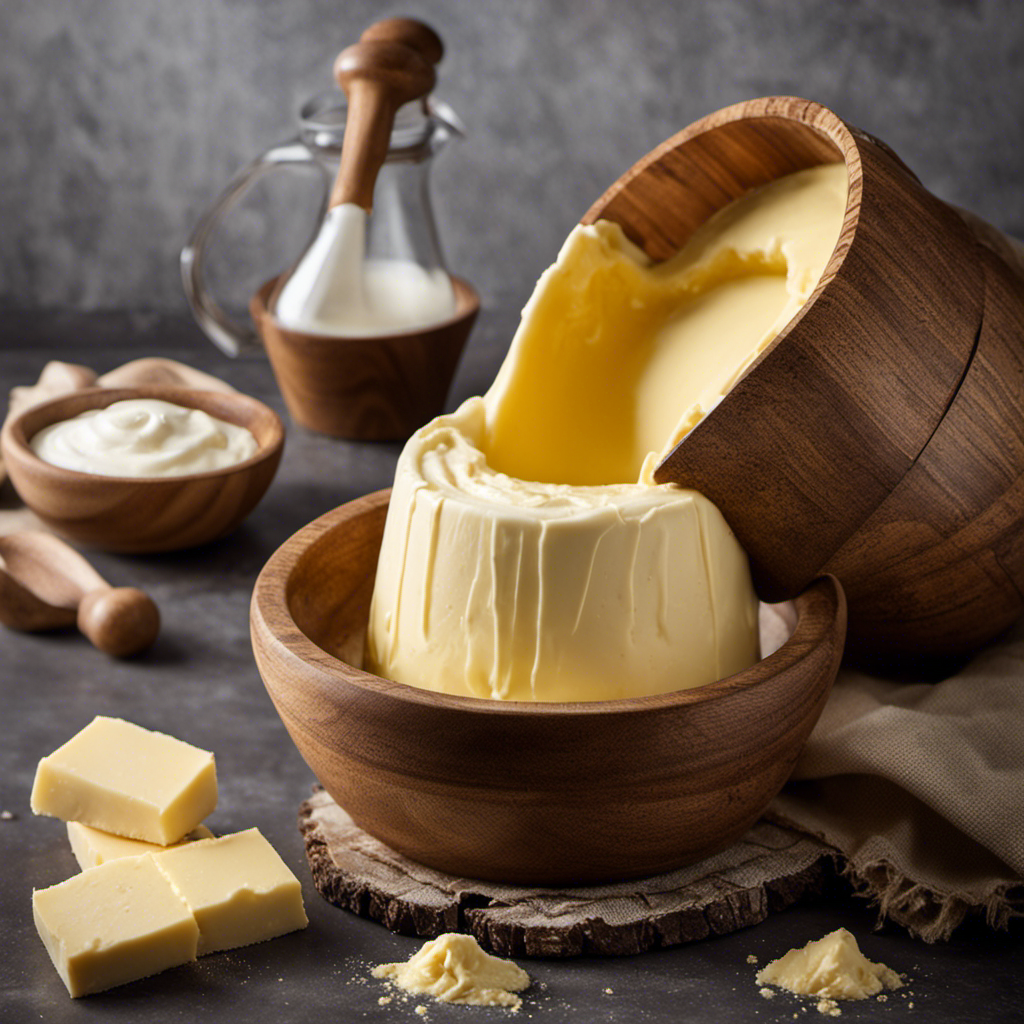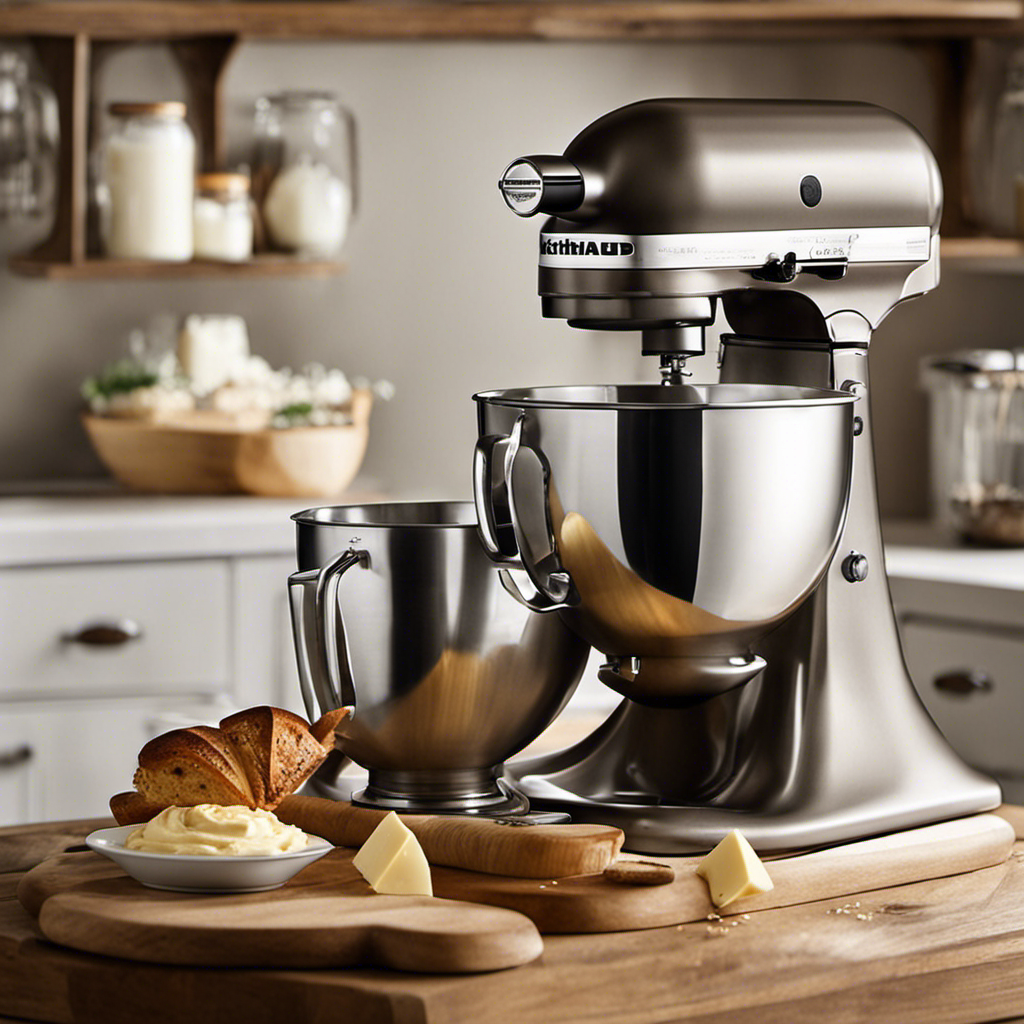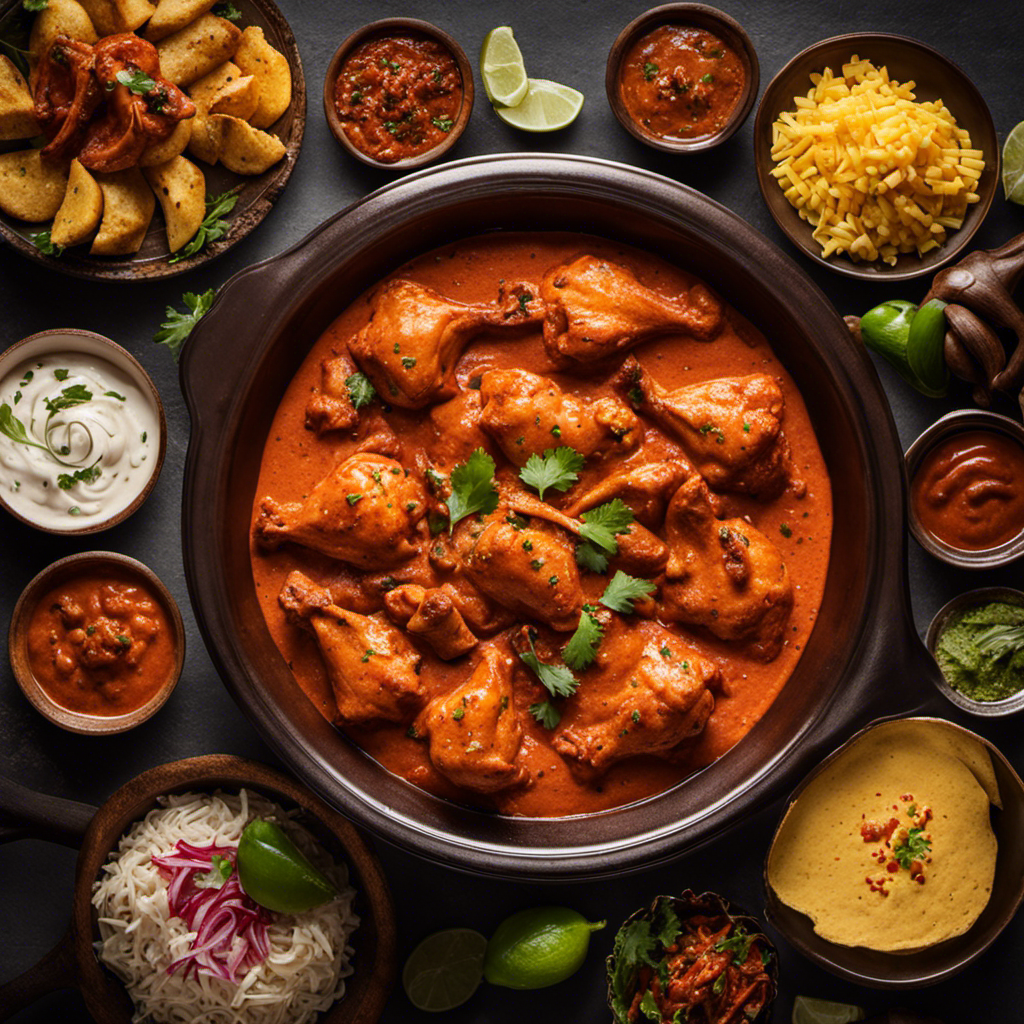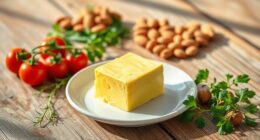Recently, I discovered an intriguing method that enabled me to create butter without needing heavy cream. That’s correct – you can make homemade butter using just a handful of basic ingredients.
It was a revelation, and I couldn’t wait to share it with you. In this article, I will guide you through the step-by-step process of making your own butter using alternative substitutions.
So let’s get started and churn up some deliciousness!
Key Takeaways
- Use milk instead of heavy cream as the base ingredient for homemade butter
- Cultivate the milk using yogurt or a specialized butter starter
- Churn the milk until it separates into butter and buttermilk
- Rinse the butter to remove excess buttermilk and store it properly to maintain its freshness and consistency
Necessary Ingredients
To make butter without heavy cream, you’ll need just two ingredients: milk and a pinch of salt. While heavy cream is traditionally used to make butter, there are alternative methods that can be equally effective.
One method involves using whole milk and allowing it to separate into cream and buttermilk. By adding a pinch of salt to the milk before allowing it to separate, you can enhance the flavor of the butter.
Another method involves using a blender or a stand mixer to agitate the milk until it separates into butter and buttermilk. Troubleshooting common issues during the butter-making process includes ensuring that the milk is at room temperature and adjusting the speed of the blender or mixer to prevent overheating.
With these alternative methods and troubleshooting techniques, you can easily make butter without heavy cream.
Alternative Substitutions
When it comes to alternative substitutions in baking and cooking, there are several key points to consider.
First, non-dairy options such as almond milk, coconut milk, and soy milk can be used as substitutes for dairy milk. These options provide a suitable alternative for those with lactose intolerance or following a vegan diet.
Second, healthier alternatives can be used to reduce the fat content in recipes without sacrificing taste or texture. For example, using applesauce instead of butter or Greek yogurt instead of sour cream can be great options.
Lastly, experimenting with flavor variations can elevate your dishes and make them more exciting and unique. Adding spices, extracts, or fruits can bring new flavors to your recipes.
Non-Dairy Options
If you’re looking for a non-dairy option, you can try making butter using coconut cream instead of heavy cream. Non-dairy butter alternatives are becoming increasingly popular due to dietary restrictions and health concerns.
Coconut cream is a rich and creamy alternative that can mimic the texture of traditional butter. To create a creamy texture without heavy cream, simply whip coconut cream until it thickens and resembles the consistency of butter. This can be done using a stand mixer or a hand mixer.
The resulting coconut cream butter can be used in a variety of recipes, from spreading on toast to baking and cooking.
Transitioning into healthier alternatives, there are numerous options that can be explored to make butter substitutes that are both delicious and nutritious.
Healthier Alternatives
Looking for a healthier alternative? Try using coconut cream instead of heavy cream to create a rich and creamy butter substitute.
Coconut cream, derived from the flesh of mature coconuts, offers a variety of nutritional benefits compared to store-bought options. Firstly, it is a great source of healthy fats, containing medium-chain triglycerides that can boost metabolism and provide sustained energy. Furthermore, coconut cream is rich in vitamins C and E, which act as antioxidants and support overall immune function.
In comparison to traditional heavy cream, coconut cream is lower in calories and cholesterol, making it a healthier choice for those watching their intake. By using coconut cream as a butter substitute, you can enjoy the same creamy texture and taste, while reaping the nutritional advantages.
Now, let’s explore some exciting flavor variations to enhance your homemade butter substitute.
Flavor Variations
To add a unique twist to your homemade butter substitute, try experimenting with different flavor variations. By incorporating creative additions and infused butter options, you can elevate the taste of your butter substitute and create a truly personalized experience.
For a savory option, consider adding herbs like rosemary, thyme, or garlic to your butter substitute. These herbs will impart a delightful aroma and a burst of flavor to your spreads and sauces.
If you prefer a sweeter twist, try adding vanilla extract, cinnamon, or honey. These additions will give your butter substitute a hint of sweetness and make it perfect for spreading on toast or pancakes.
Remember to start with a small amount of the flavoring agent and adjust to taste. With a little experimentation, you can create a butter substitute that suits your preferences and adds a delicious touch to your dishes.
Equipment Needed
You’ll need a blender or food processor to make butter without heavy cream. Here are three essential pieces of equipment you’ll need for this process:
-
Blender or Food Processor: This is the main tool you’ll use to churn the cream and separate the butterfat from the buttermilk.
-
Strainer or Cheesecloth: Once the butter has formed, you’ll need a strainer or cheesecloth to separate the buttermilk from the butterfat.
-
Cold Water: After straining the butter, you’ll need cold water to rinse off any remaining buttermilk and impurities.
When making butter without heavy cream, it’s important to troubleshoot any issues that may arise. Some common troubleshooting tips include adjusting the blending time, ensuring the cream is at the right temperature, and using the right amount of salt (if desired) to enhance flavor.
Now that we have the necessary equipment and troubleshooting tips, let’s move on to the step-by-step instructions for making butter without heavy cream.
Step-by-Step Instructions
Now that we have all the necessary equipment, let’s dive into the step-by-step instructions for making butter without heavy cream. It’s important to note that there are different methods for making butter, including whipped butter and traditional butter making techniques used in various cultures.
To give you a better understanding of these methods, here’s a comparison table showcasing the differences:
| Method | Texture | Flavor |
|---|---|---|
| Whipped Butter | Light and airy | Mild and creamy |
| Traditional | Dense and creamy | Rich and savory |
| Cultural | Varies by region | Unique and diverse |
As you can see, each method and cultural technique offers its own unique characteristics to the butter. Now, let’s move on to the next section where we will explore some useful tips and tricks to enhance your butter making experience.
Tips and Tricks
Let’s discover some helpful tips and tricks to improve your butter-making experience. Here are three creative techniques and homemade alternatives that can enhance the flavor and texture of your homemade butter:
-
Experiment with different types of milk: Instead of using heavy cream, try using whole milk, buttermilk, or even coconut milk for a unique twist on traditional butter. Each type of milk will contribute its own distinct flavor profile to the final product.
-
Incorporate herbs and spices: Add a burst of flavor to your butter by mixing in herbs like rosemary, thyme, or basil, or spices like garlic powder or smoked paprika. These additions will elevate your butter and make it perfect for spreading on bread or melting over vegetables.
-
Use cultured butter starters: Cultured butter is made by introducing bacterial cultures to the cream before churning. This process adds complexity to the flavor and results in a tangy, slightly sour taste. Cultured butter can be made by using homemade yogurt or purchasing a specialized butter starter.
By following these tips and experimenting with different ingredients, you can create homemade butter that is truly unique and delicious.
Now, let’s explore the next section about storing and using your homemade butter.
Storing and Using Homemade Butter
To properly store and use your homemade butter, keep it in an airtight container in the refrigerator to maintain its freshness and prevent it from absorbing any unwanted odors.
Storing homemade butter correctly is essential to ensure its quality and taste. The airtight container will protect the butter from exposure to air, which can lead to oxidation and spoilage. It is important to keep the butter chilled at all times to maintain its solid consistency and prevent it from melting.
Additionally, storing homemade butter in an airtight container will prevent it from absorbing any odors from other foods in the refrigerator.
Once stored properly, you can enjoy your homemade butter in various creative recipes, such as flavored compound butters, butter-based sauces, or simply spread it on toast for a delicious treat.
Frequently Asked Questions
Can I Use Low-Fat Milk Instead of Heavy Cream to Make Butter?
Yes, I can use low-fat milk instead of heavy cream to make butter. By following butter making techniques without heavy cream, I can achieve the desired result using a lower fat option.
How Long Does It Take to Make Butter Without Heavy Cream?
It typically takes about 20-30 minutes to make butter without heavy cream. However, the time may vary depending on the method used and the alternative ingredients used. Troubleshooting common problems in homemade butter can help ensure success.
Can I Use a Blender Instead of a Food Processor to Make Homemade Butter?
Yes, a blender can be used as an alternative to a food processor for making homemade butter. However, it may take longer and the texture may not be as smooth.
Can I Add Flavors or Herbs to My Homemade Butter?
Yes, you can enhance the taste of homemade butter by adding flavors or herbs. There are various options for flavored butter, such as garlic, herbs like rosemary or thyme, or even sweet additions like honey or cinnamon. Experiment to find your preferred combination.
How Long Can I Store Homemade Butter in the Refrigerator?
I store homemade butter in the refrigerator for up to two weeks. Using alternative ingredients like whole milk or coconut cream can affect the storage duration, so it’s important to check for freshness regularly.
Conclusion
In conclusion, making butter without heavy cream is a simple and rewarding process. By using alternative substitutions like whole milk or buttermilk, you can still achieve the rich and creamy texture of traditional butter.
With the right equipment and following the step-by-step instructions, anyone can make their own homemade butter. Don’t forget to experiment with different flavors and add-ins to customize your butter to your liking.
So why not give it a try and enjoy the satisfaction of creating something delicious from scratch? Happy butter-making!










